The Coat of Arms The Coat of Arms
serving Menlo’s upper school since 1973
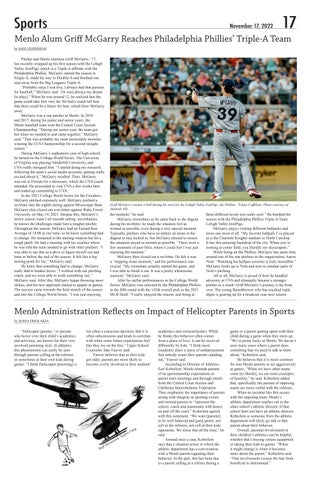
serving Menlo’s upper school since 1973

Staffillustration:SophieFang
by LIZZIE FREEHILLListening to music is common amongst teens and has the ability to bring them together. At the same time, listening to music is an individual activity that allows teens to tap into their emotions or feel good. So what happens when teens have different tastes in music than their friends? Do they introduce their friends to new music? Hide their music tastes? Or do they find common ground?
According to a survey conducted by The Coat of Arms, Menlo students listen to a variety of music genres with their friends. In the survey, 177 Upper School students voted on their favorite music genres. Out of these students, the most common favorite genre of music is pop at 19.8%, the second favorite is
indie at 16.4% and the third favorite is hip-hop at 14.1%. Other students prefer rock, country, R&B, classical, dance and electronic, or they have no preference.
However, these numbers are different when it comes to students listening to music with friends. 61% of Menlo students said that they listen to different types of music when they are with their friends than when they are alone. An example of this is that, while indie was the favorite genre for 16.4% of individual students, only 6.8% voted it to
by SOPHIE STONEHosting assemblies in the gym is an important aspect of Menlo’s student life, and faculty and students alike missed the experience over the past two years due to COVID-19. Transitioning assemblies from Zoom to the quad and back to the gym has allowed Menlo to engage in more student-led activities and improved the level of inter-grade collaboration. “A lot of other schools will maybe have two assemblies per semester, and they’re
be the most popular among their friend groups.
Junior Danae Yotopoulos finds that the music she chooses to play varies depending on who is listening. “It can feel more comfortable to share new music and genres with close friends rather than sharing them in large gatherings,” Yotopoulos said. “It is important when playing a specific playlist or a specific
song to kind of think about what other people will enjoy, but, at the same time, there is that kind of stigma around [what types of music you play].”
Music in Groups, pg. 10

really only about a big [sports] game,” Coordinator of Student Activities Frances Ferrell said. “Menlo’s assemblies aim to cover a range of things: an interesting topic, an interesting person or we try to give student groups like the [GenderSexuality Alliance] an opportunity to raise awareness about issues that affect their community members.” In addition to Ferrell, Menlo’s assemblies are organized by senior Sofia Labatt, the
Assemblies Coordinator.
Read more about Menlo’s music culture and listening habits, pg. 9-12 OPINIONS READ MORE ON PAGE 14 As Housing Crisis Continues, Atherton Debates Building New Multi-unit Homes NEWS READ MORE ON PAGE 3 Assemblies, pg. 4
According to Ferrell, Menlo plans its assemblies to cover a wide range of topics and tries to tie them into current events. While most assemblies vary each year, some cover traditional topics and are repeated each year with the same activities.

Check

Coat of

Many 18-year-old Menlo seniors were able to vote for the first time in the 2022 U.S. midterm elections. On Nov. 8, they took to the polls or mailed in their ballots to vote for the California State Governor,
various positions within the California state government, new members of the House of Representatives and one new senator. They also voted on seven ballot measures, including Proposition 1, which codifies the right to an abortion in the California Constitution, and Propositions 26 and 27, which seek to legalize sports betting.
Some eligible seniors were excited about the prospect of voting. “I want my voice to be represented,” senior Riley Jensen said.
Jensen believes that voting as an 18-yearold can empower youth voices. “I think it’s important because we’re the younger generation, so it’s important to get younger views.”
Other seniors found voting for the first time anticlimactic.
“You’re kind of told it’s a big deal, but then the ballot comes in and you look at it and it’s kind of people that you don’t really align
with all that much. And then you’re just like, ‘Oh, I guess I have to just pick one,’” senior Montse Contreras said.
A U.S. census determined that voter turnout in the 2020 presidential election was lowest among the ages 18 to 24 at 51.4% and highest among those ages 65 to 74 at 76%. According to an article from The New York Times, one of the prevailing reasons why young people don’t vote is because the acts of registering and casting a ballot are complex, especially for first time voters.

Students at Menlo have felt the same pressure when it comes to managing logistics. “[I feel] a little overwhelmed,” senior Finn Byrne said. Byrne is planning on voting in-person at a voting center. “It’s going to be hard to register, and I have to find a polling place and I have to wait in the line.”
Seniors also struggled when it came to researching candidates and relevant issues. Senior Reese Weiden, for example, found that she had limited time to spend on politics in light of approaching college application deadlines. “If I had more time, I would educate myself thoroughly, but I’m just so busy right now,” Weiden said. “I’m going to read the voter guide, but, honestly, other than that, I’m not going to do a ton of in-depth research.”
Weiden, Byrne, Jensen and senior Lucas Vogel have used their parents as resources. “It’ll definitely be a learning experience,” Vogel said. “If I go to [the] polls my first time, my parents will definitely be coming with me.”
Menlo does not host any programs targeted specifically toward educating first-time student voters. However, in mid-October, Upper School Director and history teacher John Schafer presented to a group of around 50 students and staff members about the November elections and pressing partisan matters. “That’s one of the theories on how democracy works: informed citizens participate,” Schafer said. “The more informed you are, the more power you have.”
While not all Menlo students are eligible to vote, Schafer encourages them to engage with political processes and stay up to date on current events regardless of age. “Understanding the complexities and the tradeoffs and the interconnection of issues is a really important thinking skill that I hope the school promotes,” Schafer said. “All of our students should be following the news, be civically engaged, paying attention and understanding the issues.”
Menlo boys’ Assistant Water Polo Coach and former Stanford University Head Coach Coach Dante Dettamanti died on Tuesday, Oct. 25 at 80-years-old in a bicycle crash. Dettamanti collided with a parked street sweeper on Cañada Road and was pronounced dead at the scene by the Redwood City California Highway Patrol.

A member of the USA Water Polo Hall of Fame, Dettamanti led Stanford to eight national championships in his 25 years of coaching at the university from 1977–2001. He was named NCAA Coach of the Year six times during his tenure.
“[Dettamanti] is just a monumental figure in the world of water polo,” Menlo Head Water Polo Coach Jack Bowen said. Bowen played under Dettamanti at Stanford from 1991–1995, during which time the team won two national championships. According to Bowen, this success was due to the culture Dettamanti cultivated. “He made the experience of being on that team both overtly rigorous, but also at base really playful, and I feel like I really lucked out,” Bowen said. Dettamanti raced against his players in swimming and would engage in harmless pranks with the team.
After he graduated from Stanford, Bowen remained connected to Dettamanti through their shared involvement in the water polo community. “We just had a lot of great run-ins and sort of a general staying in touch,” Bowen said. Dettamanti expressed an interest in joining the Menlo team as a coach, and, in 2019, he became an assistant coach. “I think [Dettamanti] might be the most overqualified coach in the history of sports, not just water polo,” Bowen said. “You’ve got one of the best
to ever coach the sport at the highest level and you’ve got him working with 16-year-olds in this tiny little seven-team league as an assistant.”
Dettamanti’s credentials were not lost on his Menlo players. “Everyone [at] every game introduced themselves to him, they all knew him, and it was just crazy how important of a figure he was in the water polo community,” senior Tommy Kiesling said.
According to senior Ethan Babel, the players learned a lot from Dettamanti’s expertise. “[Dettamanti] definitely helped you understand [water polo] more IQ wise because of how much he knew and how much he had seen,” Babel said. “We really tried to absorb what he was giving us.”
As a result of the COVID-19 pandemic, Dettamanti scaled back his role on the team due to health concerns. He became a consultant instead of an assistant coach, yet still attended almost every home game and watched film to strategize with Bowen. “He lived and breathed water polo,” Kiesling said.
Dettamanti passed away two days before the start of the West Catholic Athletic League tournament. “[Dettamanti’s death] came out of nowhere,” Kiesling said. “I think it brought down the team energy a lot.” During the semifinal round of the tournament against Bellarmine on Thursday, Oct. 27, Menlo lost 15-6. “Thursday night’s game was really tough. I was just not in a good headspace,” Bowen said.
In addition to Dettamanti’s passing, many players on the team were sick and unable to play, another contributing factor
to the team’s multiple losses in about a week. “It was one of the tougher 10-day streaks I’ve had as a coach,” Bowen said. However, both Bowen and the players agree that Dettamanti’s legacy lives on through the team’s practice environment. While it is common for water polo teams to swim long distances at practice, Dettamanti believed that, for water polo, it was ideal to practice swimming for short amounts of time. “The only swimming we usually do [at practice] are sprints because of him, he thinks that’s the best way to swim for
water polo, as opposed to just grinding it out,” Babel said.
In addition to the practice drills, Bowen tries to implement the “playfulness” Dettamanti emphasized. “You shouldn’t be a 16-year-old and dead serious for two hours straight every practice,” Bowen said.
While his accomplishments were substantial, Kiesling remembers Dettamanti for his attitude. “He was a great guy and just a great coach,” Kiesling said.
I think it’s important because we're the younger generation, so it’s important to get younger views.
Senior Riley JensenDettamanti (left) poses with Bowen (right) at one of the Menlo games. Bowen played under Dettamanti for four years at Stanford University, during which the team won two national championships. Photo courtesy of Jack Bowen Staff illustration: Tatum Herrin
families, according to math teacher and former resident Henry Klee, but the school tore it down in the late 2000s to make way for the gym. “It was very special,” Klee said.
noted some drawbacks to living so close to school. “There’s not a lot of separation of work and home life when you share space with colleagues,” Jordt said.
by
On a cool fall night in Atherton, residents gathered in the city council chambers to discuss the issue with the potential to change America’s richest town forever: affordable housing.
Every eight years, all local governments in California are required to write a new housing element, or blueprint for meeting state housing requirements, approved by the state. California’s Department of Housing and Community Development mandates a 375% increase in new housing units for the 2023-2031 element, according to City Manager George Rodericks.
At the Oct. 11 meeting about the housing element, Rodericks and land-use consultants Lisa Sanders, Diana Elrod and Barbara Kautz detailed the draft housing element to a crowd of mostlyAtherton residents.
Resistance to HCD requirements ran rampant when the meeting was opened to public comment. Parking, the “character of the town” and crime with the potential for gang activity were some of the concerns brought up by residents as potential issues with multi-unit housing. Residents’ claims about crime were quickly rebuked by Diana Elrod, a landuse consultant for the town.
Atherton resident Debra Holvick advocated for an amendment to the state constitution put forward by Our Neighborhood Voices. The amendment would prohibit state and local governments from allowing multi-family housing without approval from local voters. “Our Neighborhoods Voices’
S.B. 9, makes it easier to build multi-unit housing, and drew sharp criticism from many residents worried about property values. “Do I want to see God knows what [on empty lots]?” one resident asked the audience. “It will absolutely destroy the values of these homes.” They added that four lawyers told them that the law is illegal.
One commenter suggested that Atherton should pay its way out of the HCD requirements by giving money for housing to be built in other cities. Still, Mayor Rick DeGolia noted that this is not permitted under California law and that “Atherton absolutely intends to comply” with the state’s requirements.


In fact, housing was one of the dominant issues in this year’s city council election. Candidate Greg Conlon ran as a single-issue candidate in his opposition to state housing mandates, and all of the other candidates in the race put housing at the top of their issue list on their websites. “Local government should decide local rules,” Conlon said at the Oct. 11 town meeting.
Three of the four candidates who ran called to utilize empty school property for teacher housing as part of their plans to meet state requirements; however, according to Menlo School Chief Financial Officer Bill Silver, Menlo has no such space on its property. “If we had the land to do it, if it was easy to do, we would have done it already,” Silver said.
“It’s not easy.”
While the head of school’s house is the only remaining residence on Menlo’s
However, the school currently owns 10 residential units in Menlo Park, split between two properties. These are not open to all faculty but rather are rented out to new faculty recruited from outside the Bay Area for a period of two school years, according to Silver. After this period, priority for the apartments is
Jordt and Cummins also said that they believe that their apartments are more affordable than a comparable unit in Menlo Park. According to Silver, although the school charges rent at market rates for tax reasons, teachers don’t pay as much as they would for a similar apartment in Menlo Park. Silver said this is because the rent Menlo charges reflects the region-wide average for a similar apartment rather than the Menlo Park average, which tends to be more expensive. “Our rents are based on looking at [rent rates] broadly, kind of in San Mateo County and in Santa Clara County,” Silver said.
given to new teachers. “It's not long term, but it gets them here so that they have the opportunity to learn the area and to figure out where they might want to live,” Silver said.
History teacher Dylan Cummins moved into one of the apartments with his family after joining Menlo over the summer. “I love being so close to work,” Cummins said. “I can walk [to school].”
Latin teacher Jennifer Jordt, who moved into one of the apartments two years ago from Chicago, said the guarantee of housing when she accepted her job at Menlo made the cross-
According to Silver, the school is not planning on buying additional faculty housing since there is currently enough to meet the needs of new teachers. He added that the school also tries to improve housing accesibility through the Faculty Housing Loan Program. FHLP allows the school to lend faculty money to make a down payment on a home. Typically, mortgage lenders will require that the borrower pay 20-30% of the home’s sale price, according to Silver. “Often, our faculty members don’t have that money,” Silver said. “So we lend it to them.”
Another key component of Atherton’s housing element was incentivizing the development of accessory dwelling units, or separate residential units that share property with a larger house. Silver hopes the school can connect Menlo families who have an ADU with faculty and staff interested in renting in Atherton, an idea also proposed by Mayor DeGolia at the Oct. 11 town meeting.
“We’re very conscious of the challenge it is for our employees to live near the school,” Silver said. However, according to Silver, the problem comes down to supply and demand in the larger housing market. “We can’t solve the whole problem,” he said.
Town members, Atherton city officials and teachers discuss the impacts of affordable housing and whether Menlo can provide on-campus living
GEOFFREY FRANC
If we had the land to [provide teacher housing], if it was easy to do, we would have done it already. It’s not easy.
Menlo CFO Bill SilverStaff illustration: Sophie Fang
The traditional assemblies, like the National Coming Out Day Assembly and the Hispanic Heritage Month Assembly, are meant to coordinate with the theme of the month or day they take place on. Others, such as the Halloween Assembly, Holiday Assembly and Earth Day Assembly celebrate holidays.
Out Day Assembly was led by the GSA, and the Hispanic Heritage Month Assembly was led by Latinos Unidos.
“I feel like a lot of the clubs do a really good job getting a good balance of people to speak at the assemblies,” Labatt said.
In those cases, the club does the bulk of the assembly planning. “For the Hispanic Heritage Month [Assembly], Latinos Unidos pretty much owned it from beginning to end,” Ferrell said.
Ferrell still sees room for improvement in assembly diversity.
“Assemblies provide us a big platform to inform our community members about current issues. For example, I thought we could do [...] something on Native Americans in November, because I feel like that’s a demographic that's overlooked a lot,” Ferrell said.
said. “However, certain assemblies carry a more serious tone like the Mental Health at Menlo one or the [...] Veterans Day Assembly.” According to Ferrell, attendance levels have improved since the beginning of the year, as faculty have begun patrolling the parking lot to prevent students’ cars from leaving campus.
For Ferrell and Labatt, it is
important to find a balance between keeping assemblies fun and engaging for students while also addressing important messages. “We don’t want to bring speakers unless there's something that we’re super passionate about,” Labatt said. “We try to mix it up, and have fun ones like Halloween in between more serious assemblies.”
Despite efforts to engage students, Ferrell noticed a dropoff in attendance at the past few assemblies as some students left campus. “I think you can’t make everybody happy, [...] but we’re really trying to make them fun,” Ferrell
When scheduling assemblies, Ferrell accepts suggestions from faculty and students. Two recent assemblies were run by student clubs: the National Coming Menlo’s Bridge to Engineering, Science and Technology was disbanded earlier this spring. Although Upper School science teacher Dr. Nina Arnberg previously served as the club’s director, the program began a few years prior to her arrival in 2015, under former Upper School mathematics and engineering teacher Dr. Joanie Banks-Hunt.
Banks-Hunt initially created the program in order to introduce more students to Whitaker Lab. “Dr. Joanie Banks-Hunt [...] identified an opportunity to build a program with a goal of having the students who utilized the Whitaker Lab be more reflective of the overall Menlo community,” Arnberg said.
Meanwhile, Arnberg further focused MBEST’s goals on increasing interest in STEM for female-identifying students.
“My direction of the MBEST program sought to foster enthusiasm and passion for [STEM] and to create confident, skillful leaders in STEM fields, with a particular emphasis on female-identifying students,” Arnberg said.
According to Arnberg, BanksHunt sought to provide students in the program with a community of teachers, role models and peers who all strove for gender balance in STEM.
Building off of Banks-Hunt’s goals, MBEST also provided students with more access to resources such as Whitaker Lab. “Since MBEST’s inception, students [...] gained more access to opportunities in Whitaker which include freshman rotation, a variety of electives for students in grades 10-12, permanent space for middle school instruction and the
expansion of student-led opportunities like Robotics and Maker Club,” Arnberg said.
To do this, MBEST held workshops for Upper and Middle School students. According to Arnberg, workshop themes were decided by the student leadership team of MBEST; previous workshops explored topics like electric circuits and medicine. “Workshops also invited guest speakers — either working professionals in STEM [or] Menlo students — to share their experiences and leadership in STEM,” Arnberg said. “The general format included an opening speaker, hands-on, inquiry-based activity led by the student leaders and space for building community across grade levels,” Arnberg added.
A transition to full-time instruction was what motivated Arnberg’s decision to disband MBEST. Despite this, Arnberg’s continues to teach her classes with the goals of MBEST in mind. “I will continue to foster a curiosity for, and belonging to, science through teaching core science classes, as well as [continuing] to provide opportunities for female-identifying students to build confidence and connection,” Arnberg said.
Senior Aly Gregory was disappointed by the news of MBEST’s disbandment. “I have been a part of MBEST since I was in sixth grade, so hearing about its dissolution was really shocking at first [...] A lot of [MBEST members] developed a passion for STEM because of MBEST and its opportunities,” Gregory said. “It was upsetting knowing that incoming students wouldn’t get to experience the workshops, events and resources that MBEST provided.”
Junior Dorothy Zhang, who was on the student leadership team for MBEST, was similarly disappointed by MBEST’s recent dissolution. Zhang believes that MBEST provided a lot of opportunities for both upperclassmen and underclassmen. “I thought [MBEST] was a really good opportunity for upperclassmen to learn to teach and create workshops,” Zhang said. “[It was] also a good opportunity for underclassmen to just learn more and use the Whitaker Lab, which I thought was a really cool resource.”
similar sentiments about the importance of MBEST for fostering connections between the Upper and Middle School.
“I think MBEST is an important club to have at Menlo because it helps bring the Middle School and Upper School together,” Crocker said. “Plus, it champions women in STEM and helps introduce girls to STEM at a young age.”



In response to the program’s disbandment, both Zhang and junior Sanaa Kapur, as well as other former MBEST directors, are working together with Arnberg’s help to create a similar program. Kapur hopes to foster a sense of community within this program. “Many of the directors from last year [...] are still looking forward to spreading our passion for engineering and science,” Kapur said. “We wanted to create a space for middle
and upper schoolers to connect and form community [...] To me, these were the most important parts of MBEST.”
However, the new program will not be entirely identical to MBEST. “Our new version of MBEST is more focused on the Saturday workshops where we provide hands-on opportunities in science and technology for girls. [...] We won’t be able to continue some of the other internship programs,” Kapur said.
Looking back, Arnberg is proud of MBEST’s legacy. “I am proud of the impact that MBEST has had on our community of students and adults and continue to work with students who have built leadership roles through MBEST’s support,” Arnberg said.
Senior Caitlin Crocker holdsWe don’t want to bring speakers unless there’s something that we’re super passionate about.
Assemblies Coordinator Sofia LabattAssemblies Coordinator Sofia Labatt interviews students participating in the costume contest during the Halloween assembly. Photo courtesy of Kevin Chan
[MBEST] helps bring the Middle School and Upper School together. Plus, it champions women in STEM and helps introduce girls to STEM at a young age.
Senior Caitlin Crocker
With Starbucks, Peet’s and Coffeebar only a short walk away from campus, it’s no surprise that Menlo students can often be found on campus with a cup of coffee in hand. In fact, according to a study published in the Journal of Nutrition Education and Behavior, 83.2% of all teenagers consume caffeine on a regular basis. However, caffeine’s presence at Menlo is not limited to only coffee or espresso-based drinks. Energy drinks, such as Monster and Celsius, similarly possess a strong presence amongst the student body, despite their various health risks. Consequently, Menlo’s caffeine culture varies a lot from student to student — while some drink coffee solely for its taste, others opt for energy drinks to stay awake during late nights full of schoolwork.
Freshman Bella Jensen, sophomore Rena Kim and senior Evelyn Zhou drink caffeinated beverages primarily for their flavor. Kim and Zhou both drink caffeine a couple of times per week. While Kim enjoys iced vanilla lattes, Zhou prefers boba and matcha lattes. Zhou typically consumes caffeine during the day but
energy boost from consuming caffeine. Still, Sonsini chooses to drink coffee primarily for the taste. “The energy is just a plus,” Sonsini said.

increased heart rates and other various health problems in adolescents. In comparison, an eight-ounce cup of coffee contains an average of 80 to 100 milligrams of caffeine, Celsius contains much more, placing the drink into a much riskier category. “I wanted to shift to running on 80-100 milligrams of caffeine [per day],” Fish said. “Also, [Celsius contains] unsafe levels of some elements, vitamins and chemicals.”
once attempted to use it to stay awake late at night. “I’ve only [consumed caffeine for energy purposes] once because I needed to do homework, and I only got four hours of sleep afterwards,” Zhou said. As a result, Zhou would rather force herself to stay awake naturally and not consume caffeine late at night.
Unlike Zhou, Jensen has not noticed a significant connection between her caffeine intake and ability to fall asleep. “I don’t really think it gives me that much more energy,” Jensen said.
Freshman Elsa Sonsini disagrees with Jensen and experiences a noticeable
Sophomore Kirin Debnath also drinks caffeine regularly but worries about long-term health effects. “I’m worried about my growth,” Debnath said. He drinks coffee and tea on weekends for the flavor, but, on weekdays, it’s strictly for energy. Although he tries to avoid drinking caffeine at night, he occasionally does so to stay awake past 1 a.m. to finish a project or study for an exam.
Senior Nikhil Berry also relies on caffeine — in the form of tea and Celsius drinks — purely for energy. In addition to these caffeinated drinks, Berry also takes Nuun Energy tablets every so often, for when he really needs to zone in on schoolwork. Ultimately, though, Berry generally sticks to tea. “I can’t drink it at night,” he said. “I won’t be able to sleep.”
Senior Sydney Fish similarly used to drink Celsius. However, she has switched to drinking coffee for health purposes. “I stopped drinking Celsius because of the dangers of it,” Fish said. “Many people publicized online that they had health conditions because of it.” Both Fish and senior Reese Weiden noted that one Celsius contains a large amount of caffeine compared to other drinks: about 200 milligrams per can. “The maximum recommended caffeine dose if you’re over 18 is 400 milligrams. But if you’re 17, then it’s 100,” Weiden said. “So that’s concerning.”
According to the Mayo Clinic, even doses between 100-400 milligrams of caffeine can cause anxiety symptoms,
Upper School dance teacher and Menlo alumna Angela Curotto-Pierson agrees with Fish and Weiden’s concerning observations around Celsius drinks. In addition, Curotto-Pierson has noticed an unhealthy presence of energy drinks in the dance room. “I see a lot of energy drinks in this room, specifically dancers with Celsius,” Curotto-Pierson said. “And when I ask if they’ve eaten anything, the answer is usually no. Of course I’m not a doctor, I’m not licensed in any way, but something tells me that’s maybe not the healthiest form.” Curotto-Pierson also believes students at Menlo have begun consuming caffeine at a much earlier age compared to when she was a student at Menlo herself. Curotto-Pierson first began drinking coffee as a junior in high school, which contrasts the underclassmen at Menlo who she sees with caffeinated beverages on a daily basis.
While Curotto-Pierson consumes
caffeine daily, she prefers coffee to energy drinks. Additionally, Curotto-Pierson drinks coffee only early in the day. “If I have coffee in the afternoon, it wrecks my stomach, and I get lightheaded,” she said. “Also, if I had to go a day without caffeine, I [could]. So I don’t feel reliant on it.”
Even though Fish now drinks coffee instead of Celsius, her caffeine intake is still just as much for energy as it is flavor. “I drink it mainly for a caffeine boost or before a physical activity I need energy for,” she said. Similar to Fish, junior Allie Bienaime drinks coffee every morning, mainly for the energy boost.
According to Bienaime, she enjoys local coffee shops not only for the drinks and pastries, but also for the study environment. One of Bienaime’s favorite places to do homework is Coffeebar. “I started going to Coffeebar almost every morning this year, which makes it easy to grab coffee and go,” she said. “Usually I focus a lot better there than at school.”
If I had to go a day without caffeine, I [could]. So I don't feel reliant on it.
I wanted to shift to running on 80 to 100 milligrams of caffeine [per day].
Senior Sydney FishDance teacher Angela Curotto-Pierson
“
I see a lot of energy drinks in this room, specifically dancers with Celsius.
Angela Curotto-Pierson
Every October, Menlo’s senior administration team meets to start creating the calendar for the following school year. According to Director of Strategic Communications Shayne Olson, the team aims to publish the final schedule by Dec. 1. However, the leadership team must consider many factors regarding scheduling decisions before publication.
According to Olson, Menlo’s calendar uses floating holidays, which are days off that Menlo plans for specific months of the year; they are not set dates and are chosen for different days and holidays each year. “[Menlo] plans a floating holiday in October and an employee professional development day in November,” Olson said.

When planning floating holidays, the fact that Menlo students come from many different backgrounds and celebrate different holidays is taken into consideration. “Members of Menlo’s senior administrative team work collaboratively to build a schedule that will honor as many of those holidays as possible, while maintaining a regular rhythm and cadence of learning,” Olson said. Menlo must also complete the minimum number of school days required by California: 180 days.
Additionally, administrators try to plan days off from school on Mondays or Fridays, conveniently creating threeday weekends. According to Olson, long weekends make traveling easier for
students and faculty and offer students the chance to complete college tours.
During the 2022-23 school year, Menlo did not provide a day off for the Jewish holiday Yom Kippur. According to Olson, this is because Yom Kippur fell on Wednesday, Oct. 5, making it impossible to schedule a three-day weekend around the holiday. While Menlo still had school on Oct. 5, some Jewish students, including sophomore Julie Stein, opted

to skip the day and attend synagogue instead.
According to Stein, although the holiday fell on a Wednesday, having the day off still would’ve been beneficial. “I think that [Yom Kippur is] a significant holiday for Jewish people,” Stein said. “It was a lot to miss school, and it would be helpful [for the administration to give us the day off].”
According to Olson, the school still
tries to support students who miss school for religious reasons by planning blackout days for holidays that do not have the school day off. Blackout days prohibit major assessments and large projects from being scheduled or due for that day by teachers.
Like Yom Kippur, Menlo has not canceled school on Veterans Day or Indigenous Peoples Day for many years. According to Olson, if these holidays coincide with the planned floating holidays, then Menlo may give Veterans Day or Indigenous Peoples Day off. But this is rare, meaning school is usually still scheduled. “I think we should get [these holidays] off, as I’d rather have the school year be a few days longer and have those days off,” junior Nathan Chan said. “I’m not sure whether [or] not having those days off sends an implicit message that those holidays aren’t as important, but I think the administration should consider that thought when making schedules.”
According to Upper School Director John Schafer, there is no specific reason Menlo doesn’t give these holidays off. Menlo tries to observe most national holidays and chooses holidays that fall on Mondays or Fridays while also considering the rhythm of the school calendar. Although Indigenous Peoples Day is always on a Monday, the day does not align well with the Menlo calendar, so administrators plan a different day off during the first quarter instead.
Q: What were you thinking about during the pushup contest on your path to victory?
I wanted to do my best and hopefully win. I had a small feeling that I would be able to compete against all the other contestants, and I wanted to do my best and show the school that girls can do pushups too.
Q: Did you expect to win?
Not completely. I knew that there were other strong girls at the school, but I knew that if I tried my best, I would have a chance to win.
Q: What sports do you play?
I am planning to do multiple sports this year. I [played] water polo [in the fall], and I’m going to do basketball in the winter and then I’m probably going to swim in the spring.
Q: If you could meet with anyone in the world – dead or alive – who would it be?
A few years ago, when I was playing more soccer, one of my biggest inspirations was Megan Rapinoe. She was [a] strong empowerment for women, and she was so good at soccer. Another one is Kobe Bryant, just because of his mentality when it came to sports, dedication and always being the best version of yourself.
Q: If you could have any superpower, what would it be?
Teleporting or super strength.
Q: What would you fix if you were the head of Menlo?
I feel like the trash problem on the quad could be improved.
Q: Name something underrated.
Probably leg workouts. I know a lot of people don’t like leg day, but it’s really fun. Especially after when you feel like you can’t feel your legs; it’s a cool feeling.
Q: Do you have any interesting hobbies?
One of my favorite hobbies is baking. It actually came from a school project last year, and I’ve just continued to do it throughout the past year.
Q: What are some things that you’ve baked?
I’ve made plenty of things, my favorite ones being my chocolate croissants; they
were really hard. They took two days because you have to roll out the dough and then incorporate butter by rolling in a slab of butter. It was worth it in the end.
Q: What is your favorite part about playing sports at Menlo?
Probably the community, making friends and connecting with people. They’re all super supportive, nice and fun to be around.
Bianca Voltmer poses for a victory headshot after winning the girls’ pushup competition during the 2022 spirit week. Photo courtesy of Kevin ChenMenlo offers diverse electives in almost every department with the hope that students will select classes that they are truly interested in. “The goal of the electives is to offer dynamic, exciting, kind of boutique-type classes that students want to take,” Upper School Director John Schafer said.
Each year, teachers propose new electives, typically in their respective departments. If a teacher has a unique understanding of a particular topic, they are encouraged to offer a class on it. “The teacher has an interest, a background, a knowledge and a talent and offers [a class on that subject],” Schafer said.

English teacher Whitney Newton has taught the Gothic South elective for four
years now, which is a course that explores the American South and the nation’s understanding of it. Prior to Gothic South, Newton taught Literature of the American Wilderness, which was inspired by a class she was a TA for as a graduate student at the University of Michigan.
According to Newton, after teaching the American Wilderness course for four years, she was ready to explore a different subject. “I had expended my own curiosity on the topic,” Newton said.
Newton proposed multiple courses, including Gothic South, to the English department. “We have to think about how the course fits within the framework of the rest of the department because we want to have a balanced set of offerings,” Newton said. As most departments have a set number of teachers, an elective usually needs to be discontinued before a new one can be taught.
While both the English and history departments have a large number of electives offered,, the skills taught across them are the same according to Newton and Schafer. For example, while juniors take varying history electives,

they all write a lengthy research paper in the spring. “The products [students] will produce might vary, and the content they’re covering might vary, but the skills are always the same,” Newton said.
Vocal music teacher Phillip Harris currently teaches a creative arts elective
Harris proposed the concept to the Creative Arts department and began researching possible topics to focus on. According to Harris, he is constantly updating the class to suit his current students’ interests. “I hope that [my students] have a better understanding of music as a whole, and are able to articulate musical nuances within the context of American culture,” Harris said.
Schafer believes that the electives created are a combination of teachers’ experience and student interest. “It’s a combination of what teachers want to offer, what the school and department feel we should offer and what students want to take,” he said.
focused on American popular music called Ragtime to Rap. The class explores the history of American pop music and the intersection between music and American culture. Harris has an extensive background in music and was inspired to teach the class after hearing of other high schools and colleges offering similar courses.
The elective program is also an opportunity for teachers to create classes they are passionate about which energizes them, according to Schafer. Newton agrees with this sentiment. “It’s just super fun to have the freedom to intellectually explore something with a bunch of really smart kids,” Newton said.
According to Newton, when a teacher has a real excitement for a topic, it often carries to their students. “Being exposed to a topic in depth by someone who has enough background experience and context to make that topic come alive for you can make that super empowering,” she said.
The car engines slowly start and begin the trek from San Francisco to Menlo School. As the commuters watch the city pass by, their classmates in Menlo Park and Atherton sleep soundly for another hour.
While many Menlo students live within a 20-minute drive from school, others travel for nearly an hour each morning and afternoon. Senior Isabel
Staff illustration: Sophie Fang
Cordon lives 45 minutes away in Ingleside, San Francisco. Since Cordon got her driver’s license last year, she drives herself to school. When she was an underclassman, her mom drove her on the way to her job in Sunnyvale.
Cordon’s biggest struggle with living far away is making last-minute plans with friends. Before Cordon started driving herself, she didn’t want to burden her parents by asking for long rides. But, even now that she has her license, seeing friends can still be a hassle. “If we’re only going to hang out for 30 minutes, I usually can’t [attend] because it’s more time driving than actually hanging out,” Cordon said.
While Cordon often sees the commute as a chance to unwind after school, the 45-minute drive can act as yet another challenge after a stressful day. “It
also gets really tiring when life is stressful and all you want to do is go do your work,” Cordon said. “Sometimes you get that little [anxiety], like, ‘I wish I lived five minutes from school, so I can just do that or go to sleep’ because it’s sometimes hard to stay awake while you’re driving.”
Freshman Brendan Wong also comes from the North, taking the train for a 30-minute commute from San Mateo. Although he sometimes wishes that the train was just a “little bit faster,” Wong ultimately finds living further away convenient for both school and weekends. “A lot of my friends come from [my] middle school, and if other friends live farther away from me, FaceTime or meeting up at some place in the middle is convenient,” Wong said.
Similarly, after commuting from Pacifica for four years, alumna Bella Guel, ‘20, understands the pros and cons of living far away from campus. Guel started her school mornings at 6:15 a.m., got to her carpool at 6:35 a.m. and drove to San Bruno to catch the bus by 7 a.m. Following the bus ride, she boarded a 40-minute train and subsequently took Menlo’s train shuttle to campus.
Although the early mornings tired Guel, the more significant problem with living far away was that her social life suffered. “There was little to no spontaneity until I had the freedom of driving,” Guel said. “I remember that I convinced one of my senior friends on the water polo team my freshman year to tell me the [Homecoming] theme early so
I could bring an outfit, since I wouldn’t be able to go home and throw something together before the dance that evening.”
Despite these drawbacks, Guel met amazing friends on the train who helped her develop a sense of community. According to Guel, she also grew acquainted with public transport and learned how to maximize her time while commuting. “I am extremely comfortable taking public transit now and really good at time management, multitasking and planning,” Guel said. “I think that being a commuter forced me to start building these skills way earlier than the average high schooler which set me up for success in college where you are completely on your own.”
It’s just super fun to have the freedom to intellectually explore something with a bunch of really smart kids.
English teacher Whitney Newton
[I had] little to no spontaneity until I had the freedom of driving. “
Alumna Bella Guel ‘20Staff illustration: Dorinda Xiao
Upper School mathematics teacher Jude Loeffler, who is new to Menlo, first arrived in California in the fall of 1997 after an extended motorcycle trip across the United States. Prior to his journey, Loeffler taught classes in both Korea and Thailand, from 1994-1997.
Loeffler taught conversational English at an after-hours school in Korea, and, in Thailand, he taught precalculus honors at an international school, as well as a third grade class. Ultimately, Loeffler found the culture in Asia to be different than in the United States. “[Asia] was very different. [...] The way people work is different. The population density is
different,” Loeffler said. “Like here, you walk around and you don’t bump into anyone, but in Korea, you’re constantly bumping into people just because there [are] so many people.”
Loeffler first picked up motorcycling in Thailand because of how common it was. After working in Asia for around three years, Loeffler made the decision with a few of his friends to leave Asia for a motorcycle trip around the U.S. “[My friends and I] decided that it was time to leave [Asia] and come back to North America, but none of us were ready to just jump back into being full time workers in Canada or the United States,” Loeffler said. “So, instead, we got motorcycles, and we started a big crosscountry trip. Two of us left from Toronto and met the third guy where he lived in Pittsburgh, Pennsylvania, and we just started driving.”
Loeffler found the motorcycle trip to be incredibly impactful, especially in terms of exploring the diverse geography of the U.S. “All of it was memorable. Just the change in geography from state to state was amazing,” Loeffler said. “You knew exactly when you left the state because the geography changed, or you crossed a major river.”
One moment that stood out to Loeffler was when, after experiencing rain for the first three weeks of his trip, a woman in West Virginia took his and his friends’ clothes to wash and dry them. Although it rained again the very next day, Loeffler still remembers this action
as a kind gesture today.
Another memorable moment was when Loeffler and his friends came across a motorcycle rally in Sturgis, South Dakota. According to Loeffler, there were around 100,000 people on motorcycles present at the annual rally while he and his friends happened to be passing through.

During his trip, Loeffler also had a bizarre encounter with a nuclear missile base. “We had a really interesting experience in Idaho, where we had to take a detour around what looked like a military installation, but we didn’t know what it was. And then later that night, we realized that what we had driven around was a missile base,” Loeffler said.
Before finally ending up in
California, Loeffler and his friends stayed in Iowa for around a month, where they worked various jobs to save up money. “We knew we were going to run out of money in Iowa, so we ended up securing a couple of hotel jobs. [...] And then we also got jobs working in a cornfield,” Loeffler said.
By the time Loeffler finally ended up in California, he had faced his fair share of difficulties on the motorcycling trip, including having to camp and cook in rainy weather. However, stopping in California didn’t make things much easier, according to Loeffler. “I think the hardest thing was when we finally made it out to California. [...] I only had $100 and a bag of clothes — that was it. That’s what I started life in California with,” Loeffler said.
Despite this, his experience with teaching in Asia proved useful when finding a job in California. “I spent the first few years of my career teaching in Korea and Thailand so when I came to California it was pretty easy to get a credential and start teaching, mostly in the public schools,” Loeffler said. “After getting my [Master of Arts] in 2007, I started teaching at local colleges and independent schools.”
After becoming an educator in California, Loeffler also ended up teaching internet personality Emma Chamberlain at Notre Dame High School in Belmont, not too far from Menlo. “[Chamberlain] was one of the smartest students I’ve ever had,” Loeffler said.
We knew we were going to run out of money in Iowa, so we ended up securing a couple of hotel jobs. [...] And then we also got jobs working in a cornfield.
Math teacher Jude Loeffler
I think the hardest thing was when we finally made it out to California. [...] I only had $100 and a bag of clothes.
Jude Loeffler
 by KAYLIE WU
by KAYLIE WU
Within the Menlo community, live music is a popular way for students to connect with one another and simultaneously enjoy their favorite music. However, there are many factors students must consider when purchasing concert tickets, from expensive prices to scheduling around school and homework.
Senior Jack Goler values the various concerts he has attended. “I think it’s especially cool to see older artists’ performances because they’re not going to be able to tour forever,” he said. Contrastingly, senior Max Kinder has never attended a concert, and currently has no future plans of doing so. According to Kinder, he would much rather spend time with his friends in other spaces that align more with his interests.
Similar to Goler, though, freshman Malia Chen remembers her concert experiences fondly, but also understands that going to concerts on school nights is a tricky factor, as it can inhibit her learning. Since concerts are targeted towards more than just young students, they frequently take place on school nights. According to Chen, this can play a big factor in preventing students such as herself from purchasing tickets. “I would go [to a concert] if I really like the artist, but [I would] possibly have regrets when I struggle in school the next day,” Chen said.
Senior Anders Patel is a strong supporter of attending concerts on school nights. In fact, Patel recently saw Steve Lacy live at the Warfield on Thursday, Nov. 3, although he had originally purchased tickets for the Friday, Nov. 4 performance date,
which overlapped with Valpo Bowl. “Going on Thursday allowed me to still go to Valpo Bowl,” Patel said. “Concerts on school nights are convenient, because I know I’m not going to be busy doing other things those days.”
Patel also believes that general admission ticketing, rather than reserved seats, makes highly-coveted concerts more affordable. In a concert’s general admission section, attendees are often standing and dancing close together, according to Patel.“Being [in general admission] with a big crowd is so much fun. You’re surrounded and being moshed around, and everyone around you is dancing,” Patel said. “You can hear everyone singing along to the lyrics around you, and being in that vibe is completely different to being in seats. You’re definitely also a lot closer to the artist.”
Adding onto concerts, music festivals are similarly a big part of some Menlo students’ social lives. In August 2022, sophomore Andra Braicu traveled to Romania, where she attended the Untold Festival. Each night, the festival ran from 7 p.m. to 7 a.m., lasting for a total of four days. “The thing I love about concerts is obviously the music, but then also just the vibe of going to one: getting ready for it, meeting new people and so on,” Braicu said. Braicu believes that festivals are especially fun with a big group of
friends since the environment is perfectly designed for exploring and enjoying so many different activities. “I definitely want to go again next year,” she said.
Senior Isabel Cordon shares Braicu’s enthusiasm surrounding music festivals. Cordon deems attending Outside Lands, a weekend-long musical festival at San Francisco’s Golden Gate Park, a major highlight of her past two years. Cordon prefers to attend festivals rather than concerts, since she believes they offer much more than solely music. “You can go in and out of the different stages as you please. You’re kind of free to do whatever you want,” Cordon said. “You can go eat food when an artist or song isn’t really your vibe. It’s more of a full-day experience rather than just two hours.” Patel also attended Outside Lands this year and agreed the festival was filled with opportunities: shopping tents, food vendors, activities and three performing artists of different genres at all times.
Cordon also attended the recent Kendrick Lamar concert on Sept. 1 at Oakland Arena, where she saw someone nearby faint in the front row due to dehydration, moments before Lamar took the stage. “The situation was really serious,” Cordon said. “The paramedics came out to ask them a bunch of questions. I could hear everyone around me talking about how worried they were.” Even though watching someone faint will not prevent Cordon from attending concerts in the future, she still believes that it is important for people to understand both the risks of being in mosh pits and the importance of preparing water and other basic necessities in a small bag before arriving at a large venue.
 by ELLIE MCCUSKER
by ELLIE MCCUSKER
In the past 40 years, hip-hop has emerged as a mainstream and highly influential genre of music. According to The Atlantic’s “1991: The Most Important Year in Pop-Music History,” rap songs have dominated the Billboard Hot 100 charts since the 1990s. As rap grows in popularity, so does pushback toward the genre’s common themes of profanity, drugs and violence. At Menlo, 14.1% of all students reported that hip-hop is their favorite genre, raising the fear amongst parents that lyrics romanticizing illicit activities will lead to their normalization among teens.


“I just did some molly for the hell of it, I’m hyphy, and I’m drunk, I’m doin’ hella shit” are lyrics from “Order More” by G-Eazy, one of the many popular rap hits that reference casual substance abuse. According to the National Library of Medicine’s study “A High Note: Drug Misuse in Popular Rap Music,” drug abuse in the past three decades has increased alongside the praise for rap music. The study gathered that 72% of popular rap songs contain references to substances, and 50% of songs included illicit drug references. The frequency of drug mentions in rap music might create a false sense of normalcy and downplay the drug’s potential harms to listeners.
Another source of controversy in rap is frequent profanity use. “Fuck n***as, I don’t trust n***as,” is the opening line to “F.N” by Lil Tjay, one of many rap songs that use the N-word repeatedly. Many artists in the rap community believe the use of profanity in their music is empowering. For example, rapper Solange Knowles

stated that her song “F.U.B.U.” (“For Us By Us”) allows Black artists to use the N-word to regain some power and authority. “As a Black person in America, you have so many limits at every turn […] being able to say the N-word gives Black people just one small bit of power,”
Knowles told UNPLUGG’D MAG. Similarly, UNPLUGG’D MAG reports that Jay-Z only condones Black people singing the N-word in his songs because Black culture has repurposed the slur into a term of endearment. Contrastly, rappers such as Schoolboy Q encourage non-Black fans to use the N-word at their concerts, an act that other Black artists tend to find extremely insensitive and harmful.
“I wake up in the morning, I got murder on my


mind, AK-47’s, MAC-11, Glocks and .9s” is the chorus of “Murder on My Mind,” by Y.N.W. Melly, a hit rap song that primarily emphasizes violence as vengeance in the “thug” community. Many rap lyrics containing mentions of suicide, violence and sexual assault contribute to teens taking part in violence at a younger age, according to the American Academy of Child and Adolescent Psychiatry. A study from Emory University concluded that teens 14-18 who listened to rap music 14 hours a week “were three times more likely to get in a fight with a teacher, 2.5 times more likely to find themselves getting arrested and 1.5 times more likely to take part in illegal activities.” On the other hand, rap’s violent lyrics reflect the harsh reality experienced in many urban communities. Teens who relate can enjoy the feeling of community rap provides them. However, not all rap artists encourage selfdestructive behavior. For example, in 2017, while discussing the meaning of his hit song “HUMBLE.” Kendrick Lamar said, “My whole thing is to inspire, to better people, to better myself forever in this thing that we call rap.” Teenagers are constantly under the influence of the media they consume. Because studies suggest rap could affect teens negatively, it is essential to be cognizant of the weight of words individuals listen to, and how lyrics affect behavior.

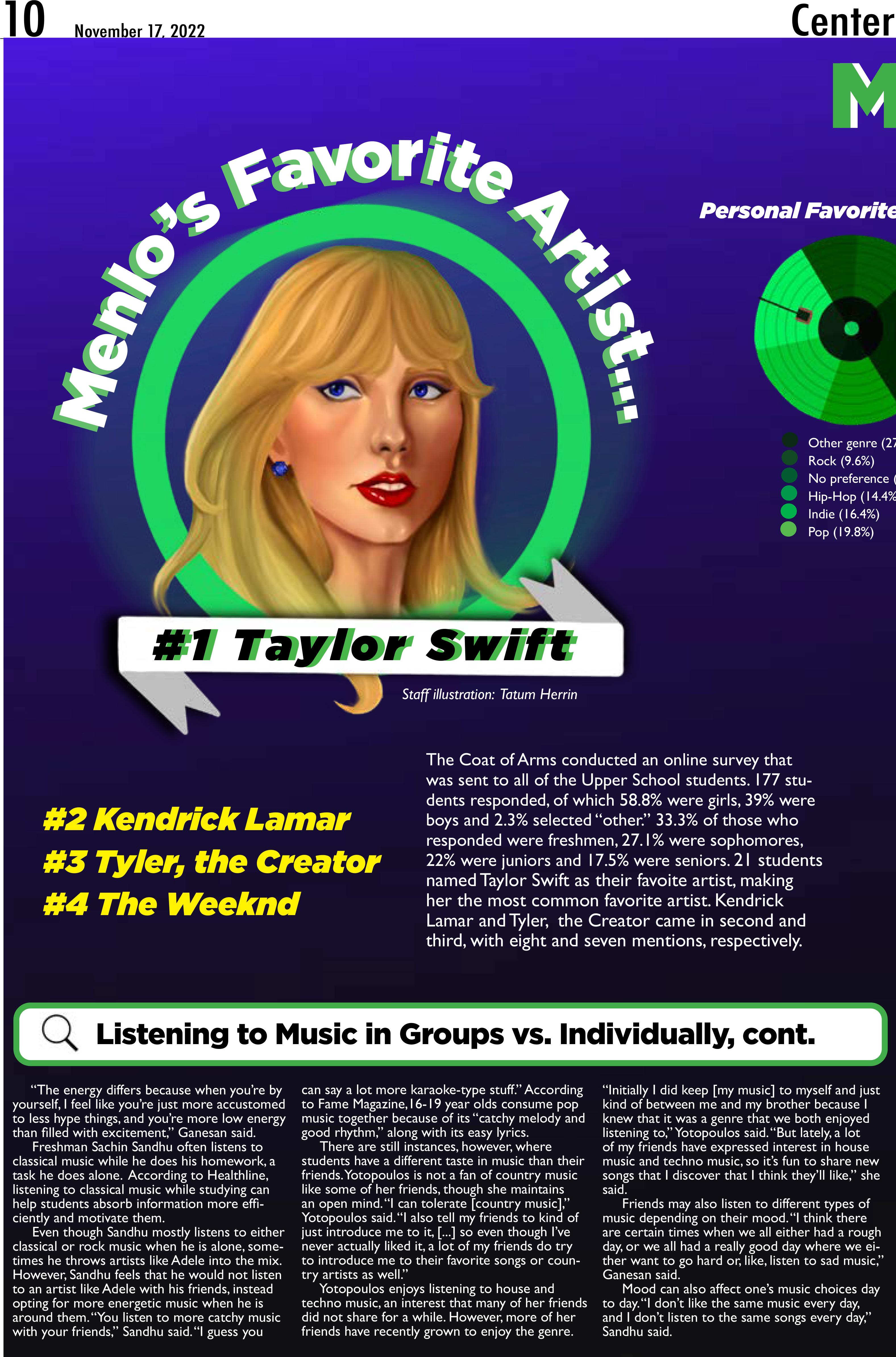
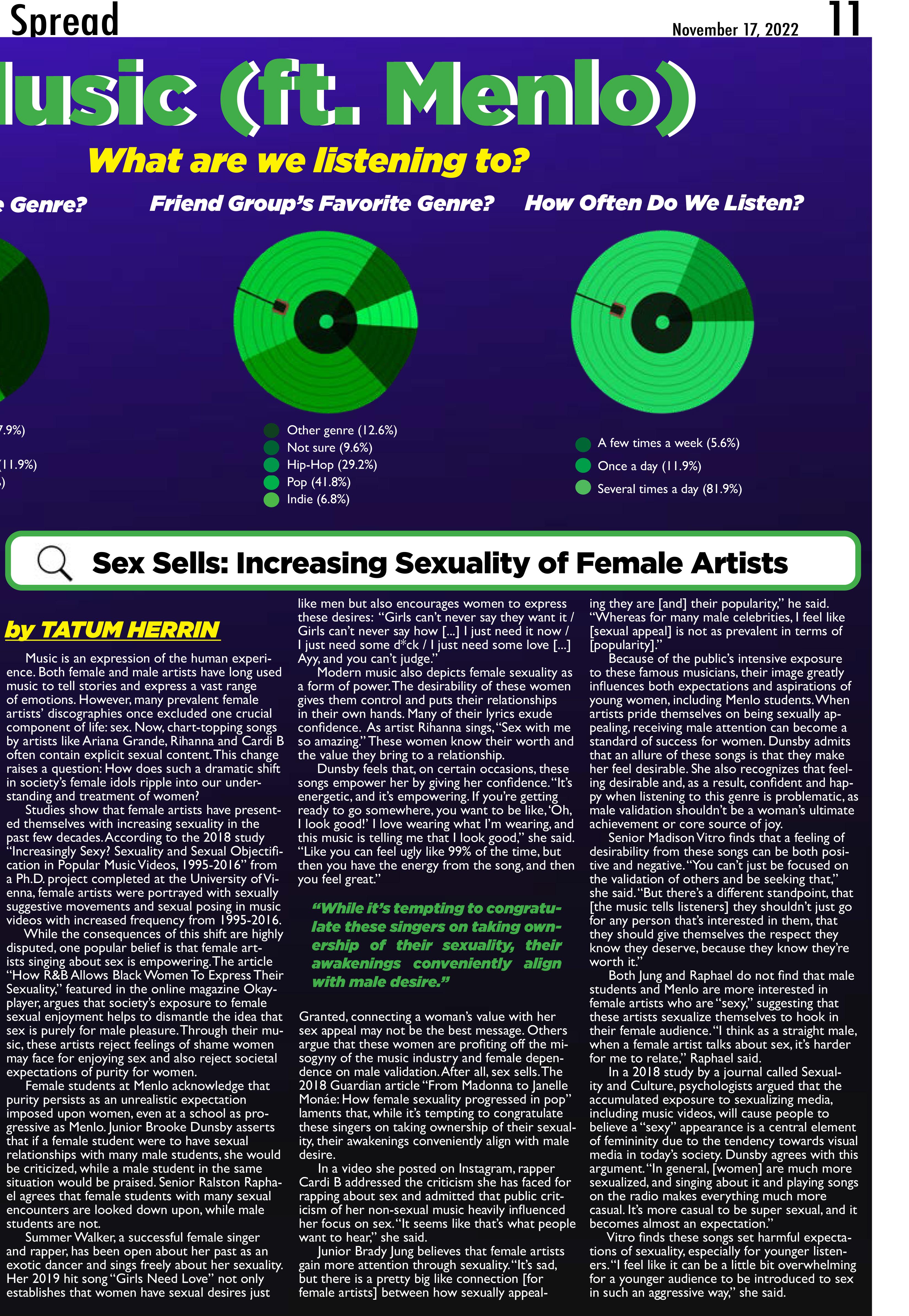
On the morning of Oct. 9, I woke up to a flurry of notifications on my phone. The New York Times, The Washington Post, CNN. On Instagram, it was more of the same: countless posts canceling Kanye West, who legally changed his name to Ye in 2018, calling for an end to his sponsorships, and labels, and shoe brands and everything that perpetuates music figures beyond the screen and into our homes and minds.
These notifications, of course, were in response to Ye’s latest tweet, which I’ll transcribe here: “I’m a bit sleepy tonight but when I wake up I’m going death con 3 on JEWISH PEOPLE. The funny thing is I actually can’t be Anti Semitic because black people are actually Jew also.You guys have toyed with me and tried to black ball anyone whoever opposes your agenda.”




After reading this tweet, I felt entirely unsurprised. Ye has always been a contro versial figure, like when he ran for president in 2020 and when he wore a “White Lives Matter” shirt at a Paris fashion show in early October. On the other hand, though, I felt angry that both my identity as a Jewish person and the identities of my Jewish grandparents and great-grandparents who had escaped persecu tion because of their beliefs were being attacked.
So, at that moment, I made a decision: I would no longer support Ye. I would no longer listen to his music. I would no longer buy his merchandise. As a high schooler, for whom music is an integral part of my life, I knew this decision would not be without consequences. After all, my music habits from statsforspotify.com prove Ye is my mostlistened-to-artist of all time, and I can deliver a compelling analysis on Ye’s albums ranked best to worst. But this minute sacrifice is inconse quential compared to the world of hurt that Ye has and will likely continue to cause.
Not only was I hurt by this tweet, but I also
felt ashamed. Why had it taken so long for me to internalize all the hatred that Ye promotes? Why did I only take action once he attacked a part of my identity, but not when he spread hatred in other communities? The truth is, even though I no longer support Ye, I should’ve stopped months — even years — ago,
the artist. After all, it’s hard to deny that Ye’s songs have entrancing flows and lyrics that are heads and shoulders above the rest of the industry. But, at the same time, it’s impossible, inappropriate and impractical to separate the art from the artist.

In today’s world, artists no longer exist only on streaming platforms and the radio. They exist all around us: on hoodies, billboards, social media and TV. They have real, public influence outside the synthesis of rhythms and beats. This level of influence can have dangerous consequences.


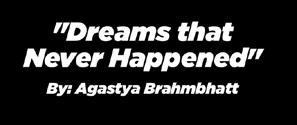
Take Ye’s antisemitic tweet. Hate groups took to a highway overpass to show their support in Los Angeles on Saturday, Oct. 22. With them, they carried a large banner that read “Ye is right about the Jews.” According to an article by the Los Angeles Times, the Vice President of the Anti-Defamation League’s Center on Extremism believes this demonstration was the “latest example of how extremists across the ideological spectrum have embraced [Ye’s rhetoric].”
As functioning members of society, we cannot continue to enable artists who spread hate and promote dangerous ideas. We must stop buying their merch, following their Instagrams and listening to their music.
We must petition their sponsors to stop giving them brand deals and money, like how Adidas and Gap dropped their products made in collaboration with Ye in response to his antisemitism. If we don’t, we show these artists that it’s okay to be hateful, and that their actions don’t have repercussions.We show their supporters that they won’t be held accountable for hurting So, you might be asking yourself, where should I draw the line? At what point should I stop listening to an artist entirely? The truth is, I can’t answer those questions for you. That is up to you to decide. But I would caution you to only support artists who you have shared goals and ideals with, and who don’t attack your or anyone else’s identity.
Music is an integral part of the lives of teens across the world, and Menlo is no different. Not only do Menlo students love to listen to music, they’re making it too.
covers live. “I usually perform in a variety of venues, ranging from formal concert halls to







ences for about a year.“I’ve been singing in the shower forever,” Mitic said. He plays in a few bands and performs at dive bars and open mic events. He first played with a Blues Trio in Boston in the summer of 2020. In California, he is in a Blues Trio with two of his good friends; one of them plays the drums and the other plays the bass.They call themselves the “Fourth Mile Band,” a reference to their favorite surf spot
in Santa Cruz. “[The surf spot] is at the four mile highway marker on Highway 1, and you run through a vineyard, down some cliffs and onto a super tucked away beach,” Mitic said. He also performs with some of his friends from Half Moon Bay. “They [are] more of an indie surf rock band,” he said.
When Nikolas Cruz murdered 17 students and teachers at Marjory Stoneman Douglas High School in Parkland, Fla., he committed one of the most atrocious and inhumane acts possible for a human being. Recently, on Oct. 13, 2022, Cruz went on trial to decide whether or not he deserved the death penalty, and, ultimately, the jury decided to sentence him to life in prison without parole, rather than the death penalty. Victims, gun control advocates and even concerned citizens alike were shocked and driven to ask the same
topics in American history, but the absurd costs and ongoing morality issues have diminished any positives. In America, it’s practically a delusion that the punishment will be carried out at all. The death penalty has lost its weight. The threat of this capital punishment no longer commands fear and discipline; rather, it evokes strain on taxpayers and religious and moral disputes.
According to the Death Penalty Information Center, 13 Americans have been executed in 2022 as of Nov. 14. These criminals spent a range of 13 to 35 years on death row prior to their executions by lethal injection. While these select few finally faced their sentence, there are over 2,400 people currently on death row.
burial and many other costs that continuously build up and take from American taxpayers. A 2011 study examined California’s death row system and concluded that, between 1978 - 2011, California’s current system had cost state taxpayers $4 billion more than a life without parole system.
Eliminating the death penalty altogether would save taxpayers and begin the necessary conversion to a criminal justice system without the death penalty. Even keeping around the option of a death sentence creates unnecessary costs and strain on everyone involved. Without the ability altogether, prisons can fully adopt a life without parole system and become more efficient and cost-effective.
that Catholics, Jews, other non-Christian religions and the religiously unaffiliated all preferred life without parole to the death penalty. While few have always had
question: If not Nikolas Cruz, who could possibly receive a death sentence?
For some, knowing a terrible criminal is executed gives a feeling of revenge or security. For others, it feels immoral and counterproductive. The death penalty has been one of the most controversial

A capital case — a case in which the prosecution argues for the death penalty — requires another level of care and resources. According to the Nevada State Legislature, capital cases are roughly eight times more expensive than a federal murder case in which the death penalty is not sought.
Even when the execution is finalized, the government must pay for more officers on staff during the execution, the executioner and necessary drugs, proper
There isn’t a heavy religious argument at play either. The Texas Catholic Conference of Bishops explained that “Catholic teaching says that the situations in which the death penalty can be used are ‘rare, if not practically non-existent.’ [...] We can’t know whether God has a purpose for a person’s life, even one who has committed a terrible crime and must spend his or her life behind bars.”
On a broader scale, the September 2014 “American Values Survey” by the Public Religion Research Institute found
passionate moral conflicts, the majority of religious groups now swing in opposition to the death penalty. With no strong voice in favor of this flawed system, there is simply no reason to keep pushing financial and personal boundaries. It’s time to end the fight for death. Being sentenced to an execution means decades of waiting and emotional and financial drain for the families involved and unrelated citizens. If anything, the death penalty causes more strain on everyone but the criminal. Victims’ families should be saved from the burden of even having this option; stop the death penalty.
If not Nikolas Cruz, who could possibly receive a death sentence?
The death penalty causes more strain on everyone but the criminal.
 by ANNIE STENT
by ANNIE STENT
“Keep your grade to yourself,” teachers often say when handing back tests or papers. However, students usually ignore this instruction, and the whispers continue as students share their grades with one another. Teachers and parents often see sharing grades as inherently bad and a way for students to compete with or shame others. In reality, sharing grades helps students understand where their score matches up and is not the cause of Menlo’s competitive environment. Plus, avoiding comparison, especially in high school, is not incredibly realistic in the first place.
It’s no secret that Menlo is a competitive school. The school profile that Menlo produces each year includes stunning matriculation data and features some of the top universities in the country. Those colleges have low acceptance rates and thus, limited spots, so admissions are competitive.
Regardless of college admissions, Menlo’s course loads are hard and workloads are heavy. The rigor promotes an expectation that students can deal with it. The level of success in Silicon Valley also lends to this. All in all, expectations are high.
Competition and high expectations do not need to be a bad thing: competition pushes people to be better. Feeling the need to stack up amongst peers and to be the best encourages hard work and highquality academic performance that may not be as prevalent without the competition.
Often, the blame for Menlo’s competitive environment is attributed to grade comparison. However, students aren’t competitive with each other because they compare themselves to one another; students compare themselves because they are competitive. Preventing students from sharing grades will not save the

school from that competition. Additionally, if Menlo’s competitive nature makes students better, then the result of this competition shouldn’t be perceived as negative either.
In order for the negative connotation around grade comparison to be removed, we need to understand where the comparison itself comes from. Students share grades in order to understand where they stand among their peers as well as how they are doing in the course in general. Without comparison, it is difficult to comprehend what a grade means and therefore which steps to take to improve. If very few students struggled on a test but you did, then maybe you could benefit from a meeting with your teacher. If your score was one of the higher, then you may not have to spend extra time improving since, comparatively, you did very well.
Sharing grades does not need to be encouraged by adults, but there needs to
be an understanding that students sharing them can provide benefits. It is unrealistic to expect that grades are kept completely secret; instead of requesting or expecting that they are and being upset when they aren’t, adults should recognize the benefits of sharing grades.
For seniors, autumn means putting in months of non-stop effort into college applications. From stressing over supplemental essays, to worrying about who else is applying to your colleges, to
community could be more welcoming and inclusive.
One way to openly acknowledge our rejections is to put them out in the open, broadcasting them on the rejection wall — an anonymous board of students who elect to post their rejection letters from colleges. It would be completely optional
Living in Silicon Valley and attending such a prestigious school, the rejection wall would provide an opportunity for students to reduce stress. According to Niche Education, Menlo ranks 22 out of 401 for Best Private Schools in California and 12 out of 1,124 Best High Schools for STEM in California, which inevitably adds to the pressure. Additionally, Atherton ranks as the number one richest town in the U.S., according to a study conducted by Veranda earlier this year. Why do these statistics matter? Menlo perpetuates these levels of stress and anxiety so
much for students. Expectations are so exceedingly high and in parts unrealistic, too. Students are in the epicenter of this melting pot.
The rejection wall wouldn’t be a place of shame; it would be a place for students to understand that it’s perfectly fine to get rejected from a university, or even a few. Not only does it help students cope with rejections from schools, but it can provide an opportunity for students to learn how to deal with adversity in future situations. Down the road, there’s inevitably going to be a time when one is going to deal with challenges and have to find a way to persevere.
A rejection wall at Menlo is something that the school should incorporate in the coming years. This practice could add a palpable way for students to cope with getting a result they never wanted to hear.
maintaining your GPA, the process feels never-ending. Come spring, we tear open our letters, praying for an acceptance, even a waitlist; unfortunately, from many of the top schools, all we get back is a rejection. This rejection brings on a new wave of emotions, particularly the belief that you might not be good enough, especially compared to your friends or peers. The reality is, normalizing the rejection process regarding college
and up to each student to decide if they want to participate. Each student would have the decision to put any rejection letter on the wall, whether that’s just one rejection letter or all of them. Although the rejection wall has faced controversy in the past, it could be changed to ensure a reduction in students’ stress.
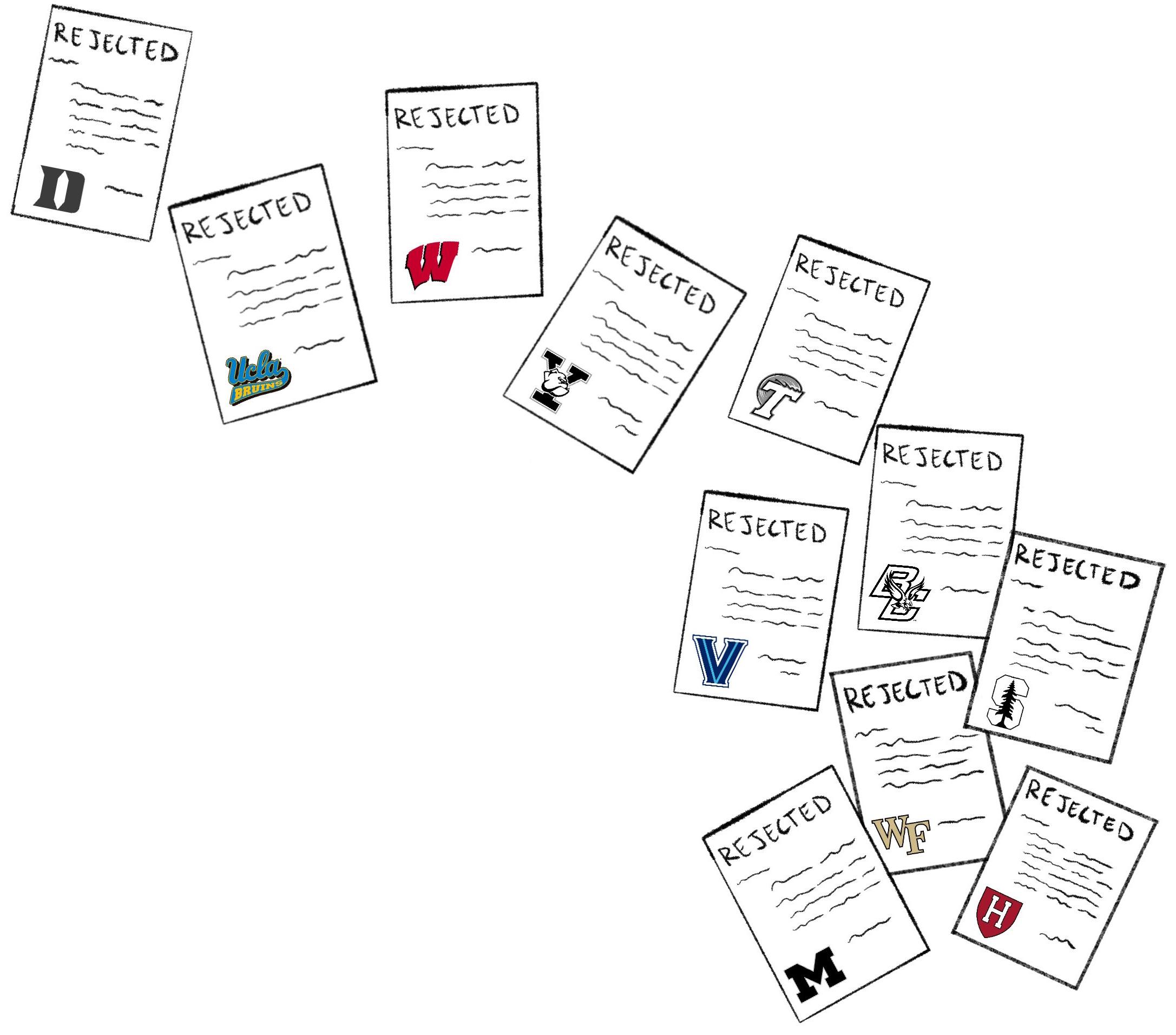
admissions will be beneficial and allow students to reduce stress.
It is common to shy away from sharing failure, embarrassment and rejection. But if we openly acknowledge rejection, as hard as that may be, our
The rejection wall would be a safe spot for students. The terms “loser,” “idiot” and “moron” might be ringing through one’s mind when they receive the email from their dream college only to see they haven’t been admitted. But what they don’t know or don’t realize is that they are not alone; other students are experiencing the same thing. Immediately, a sense of commonality would become apparent with the rejection wall. Instead of isolating yourself and hiding your rejections, you could find comfort in others who feel similar, knowing that everyone faces rejection and no one is perfect.
Normalizing the rejection process regarding college admissions will be beneficial
“ “Staff illustration: Sutton Inouye
Opinions
November 17, 2022

There has been a recent push among progressive political theorists to lower the voting age to 16. According to Vote16USA, a campaign whose primary goal is to lower the voting age to 16, a lowered voting age would have many benefits, such as making voting a habit and providing young people with a bigger stake in the political scene. In saying this, the campaign is referring to the fact that 16-year-olds can work “adult hours,” can be taxed and can be tried in criminal courts as adults. However, none of those actions should be considered fit for minors.
Building a habit by the time they are 18, while logically plausible, also really just reinforces that 16-year-olds are not ready to vote at 16 anyways. We are essentially training 16-year-olds to be effective voters at age 18, implying that they are not expected to be fully ready to vote at 16 regardless. Granting 16-year-olds the right to vote so that they are doing it consistently by the time they are adults is just prepping them to be full voters by 18. Schools can also work to build this habit by teaching and exposing students to civics before they are legal voters so that we are not putting the responsibility onto children when they are not ready to hold it.
In addition, their concerns about equal representation are flawed in that they stem from situations that are either outliers or generally not accepted as positive. As of 2020, 17.6 percent of 16 to 19-year-olds worked, showing that
working is atypical for young adults. Therefore, decreasing the voting age to compensate for teenagers working is an incorrect solution to this problem.
Furthermore, unfortunately, in California, 75 percent of youth are tried as adults. Serving adult sentences in adult prisons makes children 34 percent more likely to be rearrested once released. Often, sentencing children to adult prisons is at least partly in an effort to save money. Housing an adult inmate costs around $60,000 a year in California whereas housing a juvenile inmate costs around $300,000. Clearly, charging children as adults has an agenda behind it and is often ineffective from a rehabilitation standpoint, as well as being generally unfair. Just as with working adult hours, using the vote to compensate is not the right solution.
Those who argue that the voting age should be raised generally argue that it should be raised to 21 because 18-yearolds are often still in high school, making them more likely to be influenced by beliefs other than their own.
Before graduating, 18-year-olds will have the cushion of their high school educations as well the experience of the rest of their high school careers. These factors will support 18-year-olds in making educated decisions, but, almost more importantly, they will have more life experience than a 16-year-old would, further aiding them in their voting decisions.
16 and 17-year-olds tend to still be in high school as well, granting them the same cushion, but they also have not been through as much of high school as an 18-year-old. High school is typically
referred to as a very formative part of a person’s life; 18-year-olds are nearing the end of that formative time and 16-yearolds are still near the beginning. So, despite two years not being a very long gap, it makes a large difference because of the nature of that time frame.
Rights other than voting are granted at 18, so clearly it has been deemed that 18 years of age garners a certain level of life experience and maturity. Besides just being recognized as legal adults, 18 is the legal age of consent in California and 18-year-olds have to jump through considerably less hoops in getting a driver’s license than 16-year-olds. Lowering the voting age would simply create inconsistencies in our laws and 18 is a perfect sweet spot for democratic capability.
Staff illustration: Sutton Inouye & Michele Hratko
Editor-in-Chief............................................................Alex Levitt
Print Editor..............................................................Laura Artandi
Online Editor................................................................Ari Krane

News Editor...........................................................Abigail Becker
Opinions Editor.................................................Penelope Stinson
Arts & Lifestyle Editor..............................................Kaylie Wu
Spread Editor...........................................................Tatum Herrin
Sports Editor..............................................................Lexi Friesel
Head Copy Editor.....................................................Erica Fenyo
Copy Editors.................... Annie Stent, Lizzie Freehill, Andrea Li
Social Media Director...............................................Sophie Stone
Creative Director......................................................Sophie Fang
Design Lead.........................................................Michele Hratko
Community Relations Director..................................Alea Marks
Marketing Director.................................................Dorinda Xiao
Video Editor...............................................................Jacob Reich
Assistant Sports Editor.........................Claude Kingsley-William
Assistant News Editor...........................................Geoffrey Franc
Assistant Spread Editor................................................Zoe Adler
Assistant Arts & Lifestyle Editor............................Sonia Dholakia
Staff Writers....................................................Sutton Inouye, Jake Lieberman, Ellie McCusker
Today’s Thanksgiving is synonymous with family, food and football. Heralded as a symbol of the harmony between the colonists and the Native Americans, children today are still taught

brated from a Eurocentric point of view. It is marked as a representation of colonist survival and an endorsement of European arrival in the Americas. In these interpre-
tations, the Wampanoag are characterized as the “friendly Indians” and are given no further thought. Although progress has been made in many school systems, some still continue to teach children a myth
Americans should celebrate the Wampanoags’ generosity and kindness towards the pilgrims. The United States owes much to Native Americans, yet they are largely
 by JAKE LIEBERMAN
by JAKE LIEBERMAN
Pitcher and Menlo alumnus Griff McGarry, ‘17, has recently wrapped up his first season with the Lehigh Valley IronPigs, which is a Triple-A affiliate with the Philadelphia Phillies. McGarry started the season in Single-A, made his way to Double-A and finished one step away from the Big Leagues: Triple-A.
“Probably since I was five, I always had that passion for baseball,” McGarry said. “[It was] always my dream [to play].” When he was around 12, he realized that the game could take him very far. He had a coach tell him that there could be a future for him, which blew McGarry away.
McGarry was a star pitcher at Menlo. In 2016 and 2017, during his junior and senior years, the Menlo baseball team won the Central Coast Section Championship. “During our senior year, the team got hot when we needed to and came together,” McGarry said. “That was probably my most memorable moment: winning the CCS Championship for a second straight season.”
During McGarry’s sophomore year of high school, he turned on the College World Series. The University of Virginia was playing Vanderbilt University, and UVA really intrigued him. “I started doing my research, following the team’s social media accounts, getting really excited about it,” McGarry recalled. Then, McGarry was out in Florida for a showcase, which the UVA coach attended. He proceeded to visit UVA a few weeks later and ended up committing to UVA.
In the 2021 College World Series for the Cavaliers, McGarry pitched extremely well. McGarry pitched a no-hitter into the eighth inning against Mississippi State. McGarry also closed out a no-hitter against Wake Forest University on May 14, 2021. Despite this, McGarry’s senior season wasn’t all smooth sailing; nevertheless, he knows the challenges made him a tougher pitcher. Throughout the season, McGarry had an Earned Run Average of 18.00 at one time, so he knew something had to change. He remained in the starting rotation but hit a rough patch. He had a meeting with his coaches where he was told the team needed to go with other pitchers. “I was able to use this as a drive to figure myself out and hone in before the end of the season. It felt like a big turning point for me,” McGarry said.
He knew that something had to change; McGarry really had to hunker down. “I worked with our pitching coach, and we were able to work something out,” McGarry said. After this, McGarry began throwing more strikes, and his new approach started to appear in games. The success came towards the final stretch of the season and into the College World Series. “I was just enjoying
the moment,” he said.
McGarry remembers as he came back to the dugout during his no-hitter, he made the situation feel as normal as possible, even during a very special moment. Typically, pitchers who have no-hitters sit alone in the dugout to stay locked in, but McGarry elected to ensure the situation stayed as normal as possible. “There were a few moments of pure bliss, where I could feel I was just enjoying the moment.”
McGarry then closed out a no-hitter. He felt it was a “stepping stone moment,” and his performance was crucial. “My roommate actually started the game, and I was able to finish it out. It was a pretty wholesome moment,” McGarry said.
After his stellar performances in the College World Series, McGarry was selected by the Philadelphia Phillies in the fifth round with the 145th overall pick in the 2021 MLB Draft. “I really enjoyed the season, and being at
three different levels was really cool.” He finished the season with the Philadelphia Phillies Triple-A Team Lehigh Valley IronPigs.
McGarry enjoys visiting different ballparks and loves one most of all. “My favorite ballpark I’ve played at is the Charlotte Knights stadium in North Carolina. It has this amazing backdrop of the city. When you’re looking at center field, you literally see skyscrapers.”
While being on the Phillies, McGarry has spent time around one of the star pitchers in the organization, Aaron Nola. “Watching his bullpen sessions is truly incredible.” McGarry looks up to Nola and tries to emulate parts of Nola’s pitching.
All in all, McGarry is proud of how he handled adversity at UVA and ultimately became a stronger pitcher as a result. Griff McGarry’s journey is far from over. The young flamethrower who has touched triple digits is gearing up for a breakout year next season.
“Helicopter parents,” or parents who hover over their child’s academics and activities, are known for their very involved parenting style. In athletics, this phenomenon can easily be seen through parents yelling at the referees or sometimes at their own kids during games. “I think [helicopter parenting] is

not often a conscious decision, that it is often subconscious and tends to correlate with when some future expectations feel like they are on the line,” Upper School Counselor Jake Fauver said.
Fauver believes that as their kids get older, parents are more likely to become overly involved in their students’
academics and extracurriculars. While he thinks this behavior often comes from a place of love, it can be received differently by kids. “I think most [students] share a sense of embarrassment that nobody wants their parents standing out,” Fauver said.
According to Director of Athletics
Earl Koberlein, Menlo reminds parents of its sportsmanship expectations at parent team meetings and through emails from the Central Coast Section and California Interscholastic Federation. They emphasize the importance of parents acting with integrity at sporting events and remind parents to “represent the school, coach and teammates with honor, on and off the court.” Koberlein agreed with this sentiment. “We want [parents] to be well behaved and good sports, not yell at the referees, not yell at their kids, opponents. We stress that all the time,” he said.
Around once a year, Koberlein says that a situation arises in which the athletic department has a conversation with a Menlo parent regarding their behavior. In the past, this has been due to a parent yelling at a referee during a
game or a parent getting upset with their child during a game when they mess up. “We’re pretty lucky at Menlo. We haven’t seen many cases where a parent does something that we need to talk to them about,” Koberlein said.
He believes that it is more common for non-Menlo parents to act aggressively at games. “When we have other teams come [to Menlo], we see more examples of hostility,” he said. Koberlein added that, specifically, the parents of opposing teams are more verbal with the referees.
When an incident like this occurs with the opposing team, Menlo’s athletic department reaches out to the other school’s athletic director. If that school does not have an athletic director, Koberlein or someone from the athletic department will likely go talk to that parent about their behavior.
Overall, parental involvement in their children’s athletics can be helpful, whether that’s buying certain equipment or taking their kids to games. “When it might change is when it becomes more about the parent,” Koberlein said. “That involvement crosses the line from beneficial to detrimental.”
On Oct. 6, senior Justin Pretre announced his commitment to run Division I cross country and track and field at UC Berkeley.
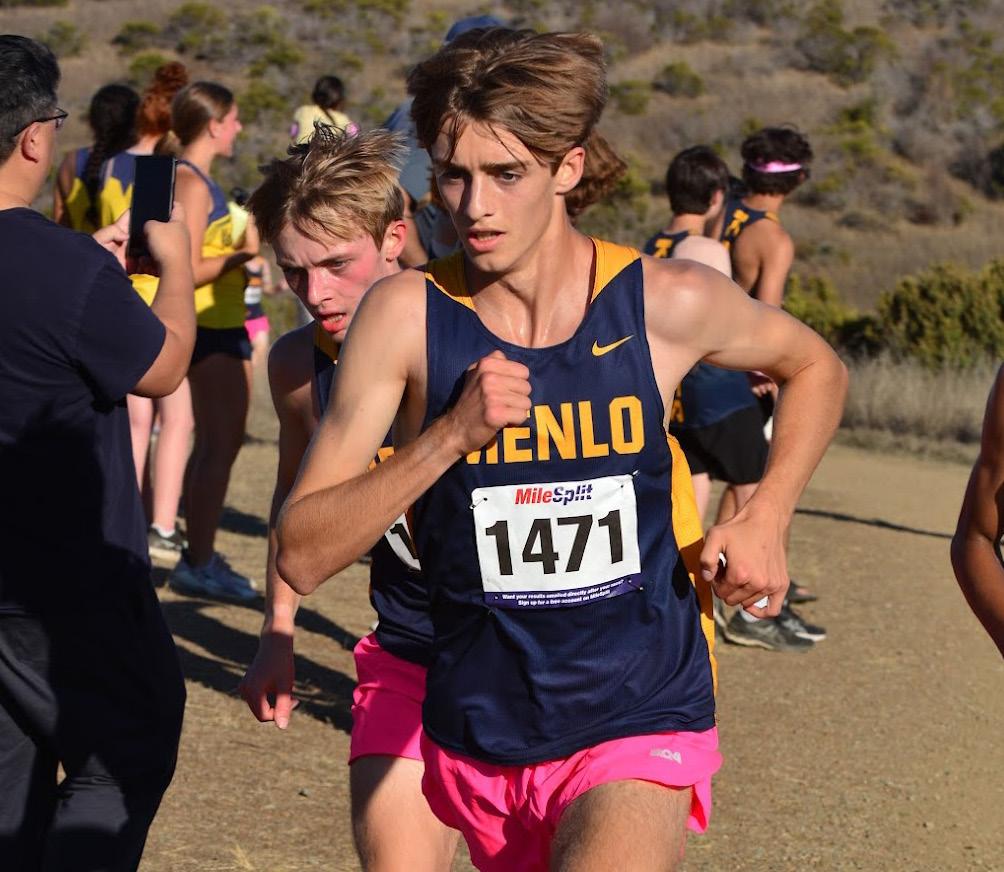
When he ran his first meet, Pretre was only eight years old. “I kind of thought that it looked like fun, so I jumped into one race [not representing a team],” Pretre said. “And then I qualified for nationals because like zero 8-year-olds run.”
Pretre played other sports as a kid, including soccer and basketball. In ninth grade, he started running more competitively, leading him to quit soccer in tenth grade to focus on running.
Since then, Pretre has competed in a variety of local, state and national races for both cross country and track and field. He finished off the 2021 cross country season by placing 14th at the California Interscholastic State Cross Country Championships. Pretre is currently the fastest cross country runner in the West Bay Athletic League, according to Athletic.net, having placed first at all league meets. During the spring 2022
track and field season, Pretre placed seventh at the Nike Indoor Nationals one mile race.
He credited much of his improvement to the coaches at Menlo. “Coach Jorge has really done a good job to develop me and keep me from getting burned out,” Pretre said of the head coach.
Pretre said his commitment decision came to UC Berkeley or Yale. “It was a really tough decision,” he said.
He ultimately decided on Cal because he saw that runners were able to excel in both athletics and academics and because he enjoyed his official visit. “I felt like I fit in with the team super well,” Pretre said.
UC Berkeley’s offer was also attractive to Pretre because of the school’s location in the Bay Area. “I like the proximity to a bunch of really cool places to run,” he said.
Pretre’s mom, Tina Lount-Pretre, said she was excited for him when he committed to Cal. “I felt happy he’s going to be close by.”
In July 2022, senior Ari Krane committed to play Division III lacrosse at Vassar College in Poughkeepsie, New York. In addition to playing on Menlo’s varsity team, Krane plays on ADVNC Lacrosse’s San Francisco, Northern California and national teams. Prior to being recruited to play at the collegiate level, Krane spent his past two summers on the East Coast for weeks at a time, where he competed in national tournaments in front of college recruiters. Krane started playing lacrosse at the age of five for the Firestarters, a 6-andunder program run by the Firehawks Lacrosse club. “I really enjoyed that, and I always kept playing because it was active and fun and I did it with some of my close friends at the time,” Krane said.

academics in college. “I kind of realized that the Division III experience would
Krane now coaches for the Firestarters program. Krane realized he wanted to continue playing lacrosse in college after COVID-19 prematurely ended his freshman season. “I was on the varsity team and got really close with a lot of [...] kids in that senior class of 2020 that were committed to play in college,” Krane said. “That inspired me to want to continue it myself, [...] and I realized that I wasn’t ready to let go.”
In addition to continuing his athletic career, Krane wanted to focus on
give me more balance between academics and athletics. [...] The Division I lifestyle [...] didn’t seem like it matched my goals for the importance of academics,” Krane said. He began looking at schools in the New England Small College Athletic Conference, a Division III conference made up of schools with rigorous academic programs. Krane visited Vassar twice and loved both their lacrosse program and academic structure.“I went from not being able to pronounce [Vassar] to really being passionate about about everything the school has to offer,” Krane said.
During one of Krane’s visits, the practice got snowed out and he ended up talking to the coach in the locker room for two hours. “It was a lot of fun and I got to understand the team culture and everything that goes along with that,” Krane said. He also enjoyed the New England atmosphere and liberal arts education Vassar provides. “I fell in love with the campus and the academic opportunities,” Krane said. “I think [having] an open curriculum was really important to me,” Krane said.
That inspired me to want to continue it myself [...] and I realized that I wasn’t ready to let go.
Senior Ari Krane
I went from not being able to pronounce [Vassar] to really being passionate about about everything the school has to offer.
Ari Krane
The Menlo Boys basketball team ended their 2021-22 season as Central Coast Section champions for the first time since 2017. During last year’s season, the team maintained a winning record of 21-8 over the year. That record included their CCS victory over Manteca High School and the NorCal Div. III quarterfinals loss against Pleasant Valley.
This season, the team looks forward to continuing their success under secondyear head coach Ben Batory. “Coach has built a really good team culture, and he looks to continue building on that,” senior Lucas Vogel said Vogel played a key role in last year’s offense. He led the team in points (17.7), rebounds (5.7) and steals (1.9) per game last season in his junior year. In total, he scored 496 points for the Knights. Senior Robby Enright also played a crucial role in Menlo’s defense, leading the team with
eight blocks.
Other notable returners include senior Will Eggemier and junior Sam Reznik who contributed to the team’s success throughout the year. Eggemeier had 16 points, five assists and five rebounds in the CCS championship game against Manteca. Reznik added an additional eight points in the same game.

Looking forward, the team will face a difficult schedule, tipping off in their first scrimmage at Saint Ignatius on Nov. 17th in a non-league matchup. Saint Ignatius also finished their 2021-22 season with a winning record, which included wins against Serra,Valley Christian and Bellarmine.
“I think we have a really hard schedule and we play a lot of really good teams,” Vogel said. “But we have a really good group of guys, so I think we’re going to have a successful season.”
The 2019 State Champion girls basketball program also looks to have a successful season this winter. Last year, head coach John Paye coached the team to a second place finish in the West Bay Foothill league with a winning 18-8 record. The Knights had a very successful run in February, winning seven straight games.
In the 2022-23 season, the Knights will face the crucial loss of several graduated seniors including center and power forward Sharon Nejad, who led the team in rebounds, blocks, steals and assists last season. “We had a lot of
Other notable players include Jensen, who fell right behind Nejad with 1.6 steals per game. “This year we’re going to have a lot of JV players coming up so it’s important that we have a lot of hard work and dedication to have a somewhat successful season.”
senior graduates last year, so we’re now a young team with a lot of underclassmen,” senior Riley Jensen said. “We’re hoping to get everyone that played JV last year accustomed to varsity.”
Many talented athletes are returning to play this year. Sophomore Karen Xin, free throw and point leader, will be back on the court at guard for her second varsity season. Senior Jordan Brooks will join her; Brooks led the team with a 47% field goal and 42% three point accuracy.
During the off-season, the team has continued to get in shape and build chemistry for the upcoming season. “A lot of us have been going to the offseason lifts and running,” Jensen said. “We’ve also had dinners for team bonding.”
The girls’ season will begin on Nov. 17 as they play Menlo-Atherton for the CCS Sportsmanship Game. The Bears ended their 2021-22 season with a 1213 record. The game will take place at Menlo-Atherton High School. The Menlo team will head to Mills High School for a tournament the following week.
The Menlo girls soccer program won their league in 2021, and they look to reclaim their title in the upcoming 202223 season.

Longtime coach Ross Ireland will return to coach the team, which ended their previous season with a record of 9-6-3. The season ended in the semifinal round of Central Coast Section playoffs with a heartbreaking 2-1 loss in double overtime to Christopher High School.
good amount of us have been going to offseason lifts which I think will help us with strength for the season,” Sellers said. “We’re definitely genuinely excited going into it.”
The girls will begin their season with a game at Cupertino High School on Nov. 29. “I’m excited for the season and can’t wait to see how it goes,” senior Hannah Gorospe said.

The Knights look to bounce back with an experienced roster of upperclassmen as well as several talented underclassmen. Seniors Colby Wilson and Sasha Bernthal will return to Wunderlich to play a key role in the team’s offensive unit. Sophomores Roya Rezaee and Audrey Hochstetler will play their second season on the varsity squad.
However, the team has faced significant adversity in the offseason. The roster lost several starting seniors who graduated in June. Also, senior Sam Sellers, the team’s starting goalkeeper, hopes to return from an injury. “I was recently hurt over the summer, so I am still working on getting back,” Sellers said. “Our team has been a low-morale club recently because of the injuries.” Other notable, and currently injured, players are senior Ellie El-Fishawy and junior Lila Gold.
The end of the season in February did not mark the final meeting of the team before the season’s start in November. “A
The 2021-22 repeat West Bay Athletic League Champion Menlo boys soccer team will return to Wunderlich this winter to defend their title. Last season, the Knights ended their season boasting a 12-4-3 overall record and a 10-1-1 league record. Their playoff run was cut short with a 2-0 loss to Menlo-Atherton in the CCS quarter finals.

This year, Daniel Hicker will assume the role of head coach on top of his role as the Director of Sports Performance. Hicker previously worked for a Major League Soccer team, the Columbus Crew, as the Director of Performance. He also has experience working for a local team, the San Jose Earthquakes. “I really like our new coach,” senior Ethan Yuen said. “I met him during the off-season lift. He’s a really great guy and it seems like he wants us to work really hard this season.”
Although some of the team’s upperclassmen graduated this spring, many talented athletes will play again this fall. In particular, juniors Andre Gonzalez
Lombera, Sandro Velazquez and Jacob Lee will play important roles on the field.
Although the team has not begun practicing yet, the players are excited to take on this year’s schedule. “Based on the players that we have on our team, I’m very optimistic about our season and our record,” Yuen said. “I think we may actually be better this season.”
The Knights will kick off their season on Nov. 30th with a league opener against Carlmont at home on Wunderlich Field.
We’re hoping to get everyone that played JV last year accustomed to varsity.
“ Senior Riley Jensen(Below) Sam Sellers kicks the ball away from the goal. Sellers plays goalie for the Knights. Staff photos: Lexi Friesel
Bundled up in winter gear, piled together in the visitor stands and hearing the faint calls and jeers from the Menlo-Atherton student section, Menlo students were ready for a student section showdown. It was Oct. 21, the night of Menlo-Atherton’s homecoming game against Menlo football, and both student sections threw cheer after cheer at each other. From the basic “Let’s Go Menlo” chant, to individuals heckling specific Menlo-Atherton
School students, there is frequently a low turnout for the majority of Menlo sports games or events. Football, volleyball and basketball games, notable exceptions, often only see increased turnout with rivalry games, such as those against Sacred Heart or Menlo-Atherton. However, when a full-sized Menlo cheering section arrives, they are dressed in theme and ready to stomp and
Some students believe Menlo has had particu lar success with the cheering section this year, in part because of the student-sponsored cheer group, Sea
ing more games [and] we’ve been doing more like student-led cheers, but, still, better from the past


Sophomore Ethan Friesel agrees that Sea of Gold has done well in terms of increasing the student section’s size. “I think that Sea of Gold this year has done an extremely good job,” he said. “Last year, I barely recall who the captains were. But I mean, of course this year, I know who every single one of them are, because they make their presence so well
Sophomore Audrey Hochstetler concurred that Sea of Gold has gotten more kids to the games, but also believes they could do more. “I remember last year, there were more kinds of announce ments about what the games were instead of just like Instagram posts,” Hochstetler
With a larger student section, it can become harder to control or manage the cheers and the crowd, especially at a rivalry game like the Menlo-Atherton one. “I do think the boundaries are pushed a little bit at a rivalry game,” senior and Sea of Gold co-captain Sam Sellers said. “And I don’t want to say [the other teams] start it, but it seems as if they don’t have as many rules re garding their cheering so then we’re like, ‘Oh, they’re doing it so let’s just do it back.’” Sellers also clarified that she doesn’t think any of Menlo’s stu dent sections have gotten completely out of hand this year. “I don’t think it’s gotten to the point where it’s super inappro priate or really demeaning towards a player
Friesel agrees with Sellers, explaining that he believes Menlo has a reputation of being cautious in their cheers and respectful towards all players. He was surprised by a few of the more provocative cheers at the Menlo-Atherton game. “That ‘Menlo Rejects’ chant at [the Menlo-Atherton game] really shocked me, but I think it’s a lone scenario,” Friesel said. Menlo Upper School Athletic Director Earl Koberlein explained that the only explicit rules for the Menlo cheering section are those laid out by the Central Coast Section organization which hosts Menlo’s game. However, he described that he meets with the Sea of Gold leaders before games to confirm the attitude of the game. “We’ve just kind of encouraged them, ‘This is how we want you to portray the school, this is what our
expectations of you are, we hope you understand.’ And then [we] have a discussion of what’s positive, what’s negative, what’s appropriate, what’s not,” Koberlein said. When a cheer goes too far, Sellers clarified that there’s not much the Sea of Gold leaders can do until after the cheer has finished. “After the fact, we’re like ‘Guys like we can’t do that again’ and Earl [Koberlein] has come up to us and been like ‘You can’t say that,’” she explained.
Although Sellers is one of the three female leaders of Sea of Gold, she’s also noticed a gender divide within the cheering section and explained that she often worries about the perception of her leading a cheer. “I do think, like, ‘Oh, what if we’re not as good as the guys?’ so it’s kind of a weird dynamic,” Sellers said.
Hochstetler noted that the gender divide might be in part due to the layout of the student section. “I think it’s also kind of separated in terms of where people stand. Usually, the senior guys are in front, and then senior girls are like, a little bit behind them,” she said.
Koberlein noticed that boys are often the ones leading the student section when it gets a bit too rowdy. “I think it’s often more of the boys that would be boisterous and maybe even cross the line,” Koberlein said. “I think it’s more likely to be boys in the crowd that are the ones who are a little too rambunctious.” However, Koberlein also described that the same group can also contribute to the crowd productively. “It is also those boys that we can go to and ask to clean it up and help influence the rest of the crowd in a positive way,” he added.
Vogel noticed a similar trend. “Leading those chants, usually it’s boys, not to be sexist or anything, but that’s just what I’ve been observing,” Vogel explained. “And there are girls that carry the load and get loud and cheer, but heckling the players and starting the [more aggressive] chants, it usually comes from a good group of 10 [non-Sea of Gold affiliated] guys doing that stuff.”